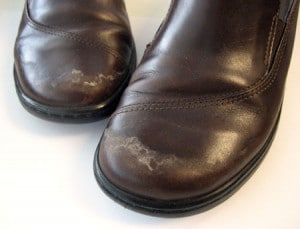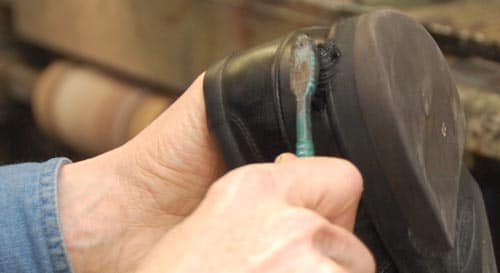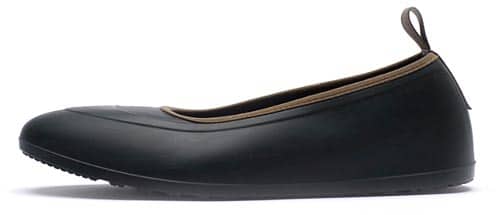A pair of well-made shoes are expensive; they become much more expensive, however, when you have to retire them early because you did not care for them properly. I recently learned this hard way when the leather on my favorite pair of Chelsea boots cracked. Although I had waterproofed them according to my “Texas” standards (weekly polish, twice a year waterproofing compound application), I learned rather painfully that this was woefully inadequate for a Wisconsin winter (think daily polish, weekly waterproofing or better yet wearing galoshes). Accidentally leaving them near my bedroom’s radiator didn’t help the situation either. In an effort to prevent my misfortune from becoming yours, I offer you this article on how to prevent rain, snow, and salt from damaging your shoes.

I’d like to thank Paul Herwaldt for his help on this article – he’s a 3rd generation cobbler who owns Shoe Repair Plus in Green Bay, WI. FYI, he performs shoe repair via mail at a fair price – highly recommended for those of you who do not have access to a local cobbler.
Why Care About Weatherproofing Your Footwear?
Water & Salt Damage is Expensive – Water can and will destroy the suppleness of your shoe’s leather; leather that would have withstood tens of thousands of flexes can have its life cut to a fraction of this. Leather is animal skin, most often cattle or horse, which is made up of fat and proteins that retain a set amount of moisture after being tanned. The fibers that criss-cross each other in the corium give leather its unique strength, but are also susceptible to drying out and cracking if not treated with care. You must minimize rapid influxes and releases of moisture and exposure to alkalines or acids, both of which can permanently damage the leather.

In addition, salt and other harsh chemicals can stain leather. They are difficult to remove once they permeate the leather itself, and if left untreated will not only discolor but weaken the top layers and can damage the finish. A simple layer of waxy polish between the leather and these harmful elements could be the difference between a one minute cleaning versus a costly trip to the cobbler.
Comfort –Wet feet are uncomfortable and most of us do not have the option of taking our shoes off and walking around in socks at work. Nothing can ruin a Monday morning presentation like cold wet feet and squeaking shoes. Why let something you can control become a distraction?
How to Make Your Shoes Water Resistant
Notice that I didn’t say waterproof. No amount of polish or “waterproofing” spray is going to keep out water if you are continuously subjecting your footwear to the elements. However, performing these steps are important as that they do provide short-term protection. Even the man who owns galoshes does not always have the luxury of having them handy when the weather takes a turn for the worse.
1. Select a Waterproofing Compound
There is a lot of debate on the subject of which waterproofing compound is best – not only are the brands fighting it out (as expected) but many shoe aficionado’s have their take as to which method and technique works the best. So please add your tips and suggestions in the comments!

Wax-based polishes – Unlike shoe pastes and creams, which are designed more to nourish the leather, wax based polishes are made to create a shine and by doing so create a thin protective layer than can provide light resistance to water and salt. Manufacturers such as Lincoln make a good product, along with Meltonian who also provides their polish in a wide range of colors. The key to this type of protection is consistent application after every few wears, or every wear if the weather is particularly wet.
Specialty waterproof compounds – Obenauf’s Heavy Duty Leather Preservative and Sno-Seal Weather Protectant are just two examples of waterproofing compounds whose main purpose is protection – they do a solid job when applied properly and have a longer sticking period than polishes. Unlike the above mentioned compounds, these protectants are not meant to create a shine but rather to seal out moisture; as such they may need to be used in conjunction with a polish once the seal has been set.
Spray on waterproofing compounds – Of all the waterproofing techniques, this one receives the most amount of flack. Common arguments are that it doesn’t allow the leather to breath and that if the compound contains silicone it will dry out the leather. My stance is if ease of use is your concern, then it’s much better to use a spray on waterproofing than nothing at all. Companies such as Meltonian make a water & stain protector that in my experience is safe to use on leather and suede and will be dry and ready to use in 30 minutes. These waterproofing sprays should be used liberally, as I learned they lose their effectiveness after only a few wears. They are not meant to penetrate the leather, but rather form a protective coat on top of it.
2. Test & Prepare for Waterproofing
This next step is especially important for any shoe that is not black – you need to ensure the compound you have chosen does not change the appearance of the shoe. Do not assume that because the waterproofing compound manufacturer claims that it will not affect color that it won’t – you do not want to be the exception to the rule. Choose a discreet part of your shoe, such as the side of the shoe’s tongue under the laces, and apply a small amount to see how it reacts. After you are more confident, move to an area like the inner back of the shoe and test again. After a few hours you should be ready to move forward. If you haven’t already, remove the laces and thoroughly clean the shoe with a brush and rag to remove dirt.

3. Apply the Water Resistant Compound Evenly and Ensure a Barrier Is Formed
The only difference in a waterproof compound application vs. a shining compound application is the attention you should pay to forming an unbroken seal. When shining your shoes you can spot shine on occasion – when waterproofing you need to ensure a water tight barrier is formed or the whole process is for naught.
For a refresher on how to apply polish to your shoes visit this older AOM article, take a look at our complete guide.
Choose the Right Footwear
Beater Shoes – One option I hear often suggested in dealing with adverse weather is to wear shoes that you do not care about. The problem here is that this doesn’t deal with the situation of when you need to look professional and the weather outside is cold and wet. I personally would rather have the right equipment than have a pair of shoes whose sole purpose is to be ruined in bad weather.

ECCO Berlin GTX
Specialty Footwear – There are many companies that make solid footwear using water-resistant materials such as gortex, synthetic leathers, and non-slip rubber soles. Although they are not on the same level as higher end men’s shoes and do not offer as much protection as galoshes, their stylish design and inclement weather durability make them a favorite among practical men. An example is the ECCO Berlin GTX – as you can see above, its large sole and open laced design make it a less dressy shoe than a classic oxford. But when it comes to not having to worry about the rain or snow and for the man who does not want to be hassled with multiple pairs of shoes, these are hard to beat.
Boots – From hiking to work, boots are made to be tougher and are a great choice for inclement weather thanks to their height and ability to protect the ankles. Unfortunately they are limited in the range of clothing they can be worn with; anything dressier than odd trousers is stretching their boundaries. Although the dress boot has a wider range and can be worn with a mens suit, it provides less protection than its rougher brethren. Due to its more delicate sole and smaller heel you’ll have less clearance when traversing puddles and thus dress boots should be worn with as much care as dress shoes. With all that being said, all boots should be treated regularly with a waterproofing compound depending on the wearers environment and frequency of wear.

Galoshes – Galoshes are rubber footwear that slip over shoes and protect them from the elements. The term includes both over-shoes and over-boots, the difference being the amount of protection afforded the wearer. With a history of serving men (and women) for over 100 years, they have perfected the art of keeping the wearer dry by completely encapsulating the feet and as an added bonus often provide excellent traction. Their downside is that proper fit is a must and their additional weight can take some time getting used to – there are also the problems of where to store them and that they are often at home when that unexpected afternoon shower hits.
A good pair of new galoshes can range in price from $20 to well over $150, the difference being durability and style although a very solid pair for occasional wear can be found for less than $30. Companies like Swim offer a wide range of durable and stylish galoshes online; for the man walking more than a quarter mile to work daily in wet weather these are one of the smarter purchases he can make.

What to Do When Your Shoes Are Already Wet?
I’d like to end this article with the steps you should take in the case you do soak a pair of quality leather shoes. Because despite all of your planning, you’re bound to get caught in the rain once!
- Remove excess water from the outside of the shoe using a dry rag or towel.
- Pull the moisture from the inside of the shoe. This can be done with newspaper or a small dry towel. The key here is to draw the moisture out, so every hour or so replace the moist paper with dry paper. Depending on the extent of the soaking, this could take from 2 hours to 2 days.
- Do not place the shoes near a heat source; let them dry slowly at room temperature. If you heat them you will cause the moisture to leave too quickly and greatly increase the chance of the leather cracking. Cracked leather cannot be fixed on a man’s shoe or boot.
- Once the shoes appear dry and no more moisture is being drawn out of the shoe, clean and condition with a leather balm or cream and finally polish normally. Over the next week ensure you clean and polish after every wearing.
_________________________________
Written by
Antonio Centeno
President, www.ATailoredSuit.com
Quality Custom Clothing & Sound Style Advice


